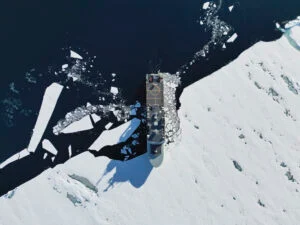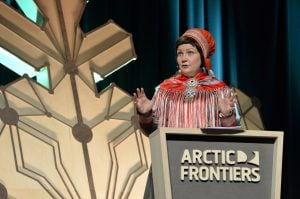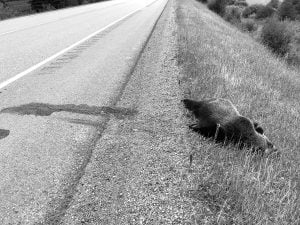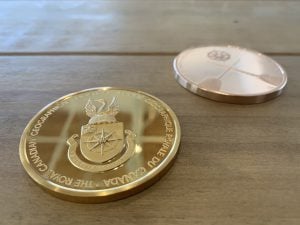
People & Culture
On thin ice: Who “owns” the Arctic?
As the climate heats up, so do talks over land ownership in the Arctic. What does Canadian Arctic Sovereignty look like as the ice melts?
- 4353 words
- 18 minutes
Wildlife
What Wildlife Conservation Society Canada scientists discovered after examining a colony of thick-billed murres in Cape Parry, N.W.T.

Often referred to as “penguins of the north”, thick-billed murres are pursuit-diving seabirds that can dive down to up to 200 metres, but unlike penguins, these birds can fly! Although not terribly efficiently because their short wings are adapted for use underwater. Like penguins, however, murres are dealing with a rapidly changing environment thanks to climate change and other anthropogenic stressors.
How murres respond to these changes and what this tells us about the Arctic environment was not well known, at least when it came to their one small, isolated colony in the western Canadian Arctic.
Over two seasons of fieldwork, Wildlife Conservation Society Canada (WCS) scientists set out to discover more about a unique colony of thick-billed murres located in the Cape Parry Marine Bird Sanctuary, which is part of the Anguniaqvia niqiqyuam Marine Protected Area (ANMPA) in the Inuvialuit Settlement Region, N.W.T. Never before studied, this colony consists of approximately 800 individuals and is located 1,300 kilometres from the next closest murre colony.
We set out to study this colony because seabirds can be useful indicators of changes in ocean conditions. Their behavioural responses to changes can be carefully monitored thanks to technology like tiny transmitters that can be attached to individual birds. These transmitters allowed us to monitor behaviours like foraging distance, diet, and migration details like timing and route. Identifying key feeding or core-use areas during reproduction (when seabirds are tied to the colony) and during migration (when they can move across oceans) is an important step toward understanding their habitat needs. It can also help us identify potential threats they may encounter, and by doing so, monitor the effect of natural or human-induced changes in marine ecosystems.

After almost two years of preparation and delays due to COVID-19, we landed in Cape Parry in 2021 and then again in 2022. In both years, our mighty team consisted of two Inuvialuits from Paulatuk, Joe Ruben Sr. (wildlife monitor) and Waylon Green (assistant), along with WCS Canada scientists Dr. Stephen Insley, and me, Dr. Rosana Paredes. In 2021, days were cold, and sea ice was near shore with lots of polar bears and seals in the area. That year, we saw a female polar bear with cubs hunting seals — best nature show ever! When we first arrived at the colony in 2021, we weren’t sure about the timing of hatching, which was critical for our work, so we were very excited to find chicks just beginning to hatch. Our timing, it turned out, was perfect!
So how do you follow even weak fliers on their near and long-distance journeys? We used both geolocator transmitters during migratory periods and GPS transmitters with depth sensors (to track diving) for more static monitoring during the breeding season. To outfit the birds with these tiny devices, we had to capture each bird twice, a tricky task with skittish birds. However, we were relatively successful with recovering devices and downloading data.


The downloaded data helped us identify the main feeding and breeding locations as well as migration routes. We gathered additional information on their diet by observing the birds directly and monitoring what was being delivered to chicks as well as indirectly by analyzing stable isotopes from feather samples. In addition, we measured the birds and sexed them by using DNA analysis of chest feathers.

Cape Parry murres feed mostly near the colony, making trips up to 17 km to feed their chicks. As a result, their main core-use areas are mostly protected under the marine limits of the ANMPA. Chicks were fed mainly with small fish. Both parents forage in the same areas, but they were active at different times of the day. Females, smaller in bill size, only foraged during daylight, while males also fed during the Arctic night. Cape Parry murres dived down as much as 70 meters but made shallower and more frequent dives at night.
The most exciting result of our research was the discovery that after breeding, Cape Parry murres took a long westward journey of about 3,600 km toward the Bering Sea, as far south as the Aleutian Islands. As expected, males were slower than females reaching these grounds, given their parental duties with the chick. Although both parents take care of the chick at the colony for a short period (15-20 days), males alone finish raising their chicks at sea for at least one month. During this time, both the molting male and the growing chick are flightless and, therefore, vulnerable to ocean disturbances such as ship traffic, which is predicted to grow due to increasingly ice-free Arctic waters.
After working with thick-billed murres colonies at both ends of their latitudinal range, getting to work with Cape Parry murres was like putting the last piece of a puzzle together. Acquiring a better understanding of what the future may hold for this particularly isolated colony says a lot about the value of field science. We now have new insights into these interesting birds and what they are telling us about changing Arctic ecosystems, and we hope it is just the beginning of our efforts to learn more about these “penguins of the Arctic.”
Are you passionate about Canadian geography?
You can support Canadian Geographic in 3 ways:

People & Culture
As the climate heats up, so do talks over land ownership in the Arctic. What does Canadian Arctic Sovereignty look like as the ice melts?

Environment
The uncertainty and change that's currently disrupting the region dominated the annual meeting's agenda

Wildlife
This past summer an ambitious wildlife under/overpass system broke ground in B.C. on a deadly stretch of highway just west of the Alberta border. Here’s how it happened.

People & Culture
Award recipients honoured in the first virtual Annual General Meeting and Fellows Show.